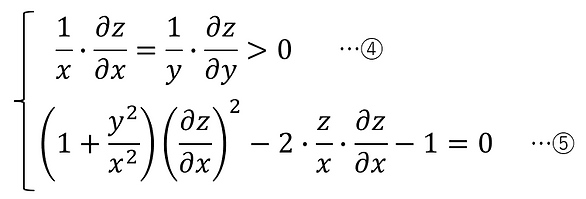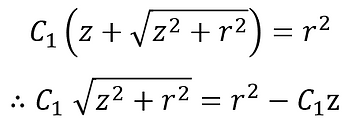Mirror shape that focuses parallel light to a single point
It is widely known that the mirror shape that focuses parallel light to a single point is a paraboloid of revolution. Here, we will derive the geometric principle that makes it so using vector theory, which was shown in another content.
Consider a mirror surface S that focuses parallel light onto a point O.
The direction vector of parallel light is defined as follows.

The coordinates of point O that is imaged to a single point are defined as follows:
Any point on the mirror surface S is defined as follows:
In this case, the direction vector of the reflected light at any point on the mirror surface S is expressed as follows:

Moreover, the normal vector of the mirror surface S is expressed as follows [1]:

The conditions described above can be illustrated as follows:

Here, the following relationships exist between the above vectors:

Therefore,

When each component is extracted, it looks like this:

From ①, ②, and ③, when x≠0, y≠0, z≠0,

Therefore,

From ④,

The method for solving this partial differential equation will be explained below [2].
The desired differential equation is expressed as follows:

In this case, consider the following auxiliary equation:

Let the solution of this auxiliary equation be expressed as follows:

Using this, we can obtain the general solution of the desired differential equation as follows:

Here, φ denotes an arbitrary function.
In ④, it becomes as follows:

Therefore, the auxiliary differential equation in ④ becomes:

Integrating both sides and solving, we get the following:

Therefore, the general solution to ④ is as follows.

Here, we put it as follows:

In this case, the only variable in z is r, so

Substituting into ⑤,

Here, we put it as follows:

At this time,

Therefore,

Here, from ④, ⑥, and ⑧,

Therefore,

Integrating both sides,

Now, for any u,

Therefore, we can remove the absolute value sign,

Putting ⑦ back into the equation,

Square both sides and rearrange,

Since r>0 (∵ x≠0, y≠0),

Therefore,

The derivation up to this point has been performed for the case where x≠0 and y≠0 and z≠0, but if we substitute the results of this derivation into ①, ②, and ③, it also holds when x=0 and/or y=0.
This shape is called a paraboloid of revolution, or a circular paraboloid.
This is illustrated below.
